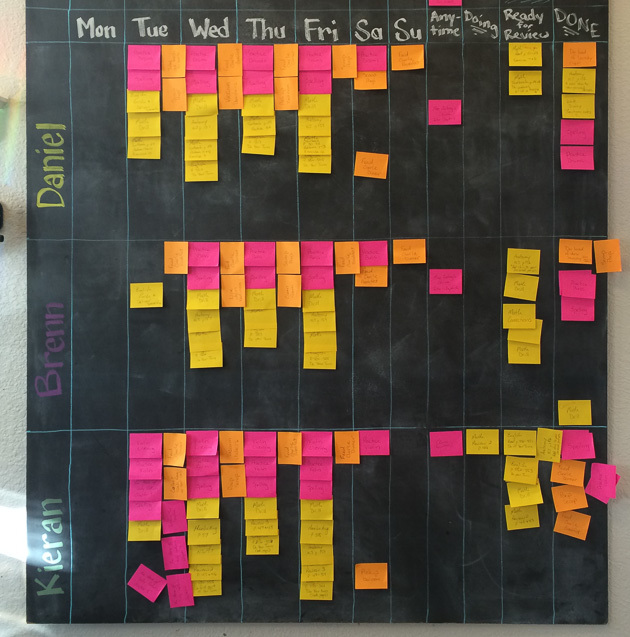Lessons from 14 Years of Agile Homeschooling for Families Suddenly in the Middle of It
https://ift.tt/2QJT37y
Lessons from 14 Years of Agile Homeschooling for Families Suddenly in the Middle of It
My wife and I have homeschooled our boys for 14 years. Two started university this year, returning home last week when their campus closed. The third is a sophomore in high school. At home, we’ve applied many of the principles, models, tools, and skills I use in my work to help individuals and teams learn and work more effectively.
You can read more about our story and our experiments in these past posts:
Agile Homeschool
Agile Homeschool Update
How We Use Agile at Home (video)
This morning, my wife, one of my college-age sons, and I put our heads together to share some tips that might help people who are homeschooling, suddenly and not by choice, due to the COVID-19 pandemic.
1. Your Family Is Not a Scrum Team
You may have had good results with Scrum at work. This does not mean it will work for you at home.
Just a few ways your family is not like a Scrum Team:
- Your family is not a dedicated team working towards a common product increment. Different people have wildly different responsibilities, commitments, and availability.
- There’s no clear Product Owner. Nor should there be. Different areas have different people who can set direction and prioritize. In some cases, it’s the person doing the work.
- There’s no clear ScrumMaster. No one can focus full-time on the system of work. Everyone has tasks to do.
- Not all the work is plannable. Things emerge every day. That’s ok. That’s just life, especially during a crisis.
Keep the principles. Experiment with some of the practices. Don’t try to apply the whole framework.
2. Make the Work Visible
If there’s one thing that has made the biggest difference for our family, it’s this. Get all the work, school and chores, onto a big Kanban board. You can find the board layout we ended up with in this post.
This works at home for all the reasons it works at work. But there’s a more important reason why it matters at home:
Your relationships are more important than the work to be done.
By moving the work to be done outside of you and your child, the work is just there. It’s not you chasing them around, trying to get them to do the work. It’s just, “Is there work left to do?”
3. Use Timeboxes All Over the Place
You’re probably also working from home now and trying to get your own things done. You’ve probably discovered that getting anything done with interruptions every two minutes is, basically, impossible.
The thing is, the kid interrupting you probably isn’t getting anything done either.
To give both of you a chance to focus and get something done, use timeboxes: “Let’s set this timer for 20 minutes. You work on your math, and I’m going to do my work. Write down any questions you have for me. When the timer goes off, we’ll talk through your questions.”
This also helped us ensure we took regular breaks and moved around instead of just sitting at the table all day long. (Breaks benefit from timers, too.)
4. Everything Seems Worse When You’re Hungry
More time together means more things to have conflict about. Those conflicts seem—and actually become—worse when you’re hungry. Plan time for meals and snacks. Don’t hesitate to call time-out on an argument to have a snack and then come back to discussing it.
5. Not Everything Is Equally Important
The 80/20 principle applies here. Not everything is going to get done perfectly every day, especially when we’re all stressed and adapting to a new way of living and working. Sometimes your energy is done before the tasks are done. That’s ok. Find the most essential part of each task. Focus on the why. Let some things slide.
Prioritize health and relationships over accomplishment. That’s what will matter in the long term.
6. It Doesn’t Have to Look or Feel Like School
As I write this, it’s the middle of the “school day,” and one of my sons is laying in bed listening to an audiobook, one is on the back porch on a Zoom discussion for a college class, and the third is doing his laundry. As long as everything is getting done, it doesn’t matter when, where, or what it looks like. Kids don’t need to sit in rows—or even in chairs!—for learning to happen. Take advantage of the flexibility you now have to integrate school, chores, rest, and play. Let your kids experience how lifelong learning is just a part of life, not something that has to happen in a classroom setting.
Finally, be patient with yourself and your family. A wise friend once explained patience to me as something like, “choosing to let go of your expectations.” It’s not having no expectations. It’s owning your expectations, acknowledging where they’re not being met, and choosing something else you value more (usually a relationship).
Leave a comment below if this was useful or if you have additional questions. If there’s interest, we may host a Zoom call to answer questions and share more tips.
scrum/agile
via Agile For All https://agileforall.com
March 25, 2020 at 02:47PM

